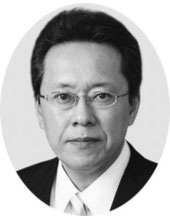Best Paper Award
A Balanced Mixer using Asymmetric Stacked Lines for a Quasi-millimeter Wave Band
Yo YAMAGUCHI, Takana KAHO, Ichihiko TOYODA, Kazuhiro UEHARA, Tadao NAKAGAWA, Kiyomichi ARAKI
[Trans. Electron. (JPN Edition), May. 2016]

Yo YAMAGUCHI
Takana KAHO
Ichihiko TOYODA
Kazuhiro UEHARA
Tadao NAKAGAWA
Kiyomichi ARAKI
Demand for wireless communication using the quasi-millimeter wave band is increasing because of the tightness of the UHF to SHF band suitable for mobile communication and the increase in communication capacity. In the quasi-millimeter wave band, an up-converter usually employs a balance mixer configuration to suppress leakage of the local oscillation signal. However, the problem with a balance mixer is that its size increases because it requires a balun that occupies a large area in an MMIC. This paper proposes a method for solving the problem.
When vertical coupled lines in a multilayer structure are made on an IC, they should become asymmetric coupled lines because their distances from the ground are different and the line at the top layer is thicker than those at the other layers on an IC.
This paper also proposes a method which analyzes asymmetric coupled lines using the S matrix of the symmetric coupled lines by introducing parameters that represent asymmetric coupling characteristics. Analysis results show that a 3 dB coupler can be developed when certain conditions are satisfied. In the method, a merchant balun on an MMIC consists of two vertically stacked asymmetrically coupled lines in series. This enables a quasi-millimeter wave band balance mixer MMIC to be miniaturized.
It also includes a spiral inductor with multi-layer lines that enables the passive elements to be miniaturized and densified. These effects were confirmed by prototyping a balanced mixer. It showed good characteristics, i.e., a small chip area of 1.56 mm2, an LO signal suppression ratio of 47 dB, and a conversion gain of -9 dB.
The work described in this paper demonstrates the methodfs effectiveness using both theoretical analysis and a demonstration with an actual IC.
The method shows great promise as a means to miniaturize and highly integrate high-frequency circuits, which addresses the major problem that such circuits increase in size when massive MIMO technology is applied to them. Therefore, we modestly concur that this paper is deserving of a Best Paper Award.












